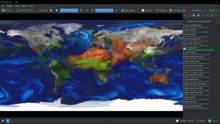Draft:C-Play
| Submission declined on 8 August 2024 by Urban Versis 32 (talk). This submission appears to read more like an advertisement than an entry in an encyclopedia. Encyclopedia articles need to be written from a neutral point of view, and should refer to a range of independent, reliable, published sources, not just to materials produced by the creator of the subject being discussed. This is important so that the article can meet Wikipedia's verifiability policy and the notability of the subject can be established. If you still feel that this subject is worthy of inclusion in Wikipedia, please rewrite your submission to comply with these policies. This submission is not adequately supported by reliable sources. Reliable sources are required so that information can be verified. If you need help with referencing, please see Referencing for beginners and Citing sources.
Where to get help
How to improve a draft
You can also browse Wikipedia:Featured articles and Wikipedia:Good articles to find examples of Wikipedia's best writing on topics similar to your proposed article. Improving your odds of a speedy review To improve your odds of a faster review, tag your draft with relevant WikiProject tags using the button below. This will let reviewers know a new draft has been submitted in their area of interest. For instance, if you wrote about a female astronomer, you would want to add the Biography, Astronomy, and Women scientists tags. Editor resources
|  |
| Submission declined on 6 August 2024 by Bsoyka (talk). This draft's references do not show that the subject qualifies for a Wikipedia article. In summary, the draft needs multiple published sources that are:
This submission appears to read more like an advertisement than an entry in an encyclopedia. Encyclopedia articles need to be written from a neutral point of view, and should refer to a range of independent, reliable, published sources, not just to materials produced by the creator of the subject being discussed. This is important so that the article can meet Wikipedia's verifiability policy and the notability of the subject can be established. If you still feel that this subject is worthy of inclusion in Wikipedia, please rewrite your submission to comply with these policies. Declined by Bsoyka 3 months ago. |  |
 Comment: The website and GitHub pages of the software creator are not acceptable sources for an encyclopedic article. Urban Versis 32KB ⚡ (talk / contribs) 03:22, 8 August 2024 (UTC)
Comment: The website and GitHub pages of the software creator are not acceptable sources for an encyclopedic article. Urban Versis 32KB ⚡ (talk / contribs) 03:22, 8 August 2024 (UTC)
| Developer(s) | Erik Sundén[1] |
|---|---|
| Initial release | August 7, 2023 |
| Stable release | 2.02[2] |
| Written in | C++ OpenGL (Qt)[3] |
| Operating system | Installer for Windows, Source code cross-platform |
| Available in | English |
| Type | Media player |
| License | GPL-3.0-or-later[4] |
| Website | c-toolbox |
C-Play is a open-source/free video/media player, intended use for science centers and/or public environments, with cluster environments where you need multiple computers and/or displays to run your content on. The displays could be flat or curved in any setup that is supported by our underlying toolkit SGCT[5] and any media format supported by mpv. The UI is built with Qt/QML.



Features
[edit]These are just some features that set C-Play apart from others media/video players.
C-Play support videos that are:
- Stereoscopic (Side-by-side or Top-Bottom) and Monoscopic
- 180 fulldome / fisheye projection
- 360 projections such as Equirectangular or Equi-Angular Cubemap (EAC), which is common on YouTube
- Any “flat” video arbitary aspect ratio
Some technical features:
- Runs a Qt/QML UI application on master computer and small none-UI GLFW/SGCT application on clients.
- Sync playback, loading and other properties between master and clients.
- Playing audio is only available on master. C-Play support change of audio output, and is pre-built with support for JACK, which opens for multi-channel low-latency output to for instance ASIO devices.
- Loading external audio files as multiple tracks.
- Editing and saving playlist and playfiles including all necassary parameters.
- Configure “sections” in a editor to create bookmarks to jump between clips inside a larger movie.
- Sync video+audio fade in/out
- HTTP Web API
- Tested and used on primarily Windows 10, in domes and other big arenas.
Packages
[edit]Binaries/installer is distributed for Windows. However the public source code itself is cross-platform.
Limitations
[edit]Testing and usage has so far only been done on Windows 10. If you need a media player for Linux and/or Mac, feel free to look into other front-end UI:s for mpv. This software is intended for usage with a master controling video on a secondary/multiple monitor(s) and/or multiple computers.
Syncronization
[edit]Syncronization is currently only applied with the use of either time from the media or the video frequency. For clustered applications, it is strongly recommend to use frame synchronization betweem the computers, that can be performed utilizing NVIDIA Quadro or AMD FirePro synchronization cards.
References
[edit]- ^ Author profile, retrieved 2024-08-05
- ^ "Release 2.02".
- ^ "The github page of C-Play". Retrieved 2024-08-05.
- ^ "c-play/License.txt at master · c-toolbox/C-Play · GitHub". GitHub. Retrieved 2024-08-05.
- ^ "The SGCT documentation". Retrieved 2024-08-05.
External links
[edit] Media related to C-Play at Wikimedia Commons
Media related to C-Play at Wikimedia Commons- Official website
